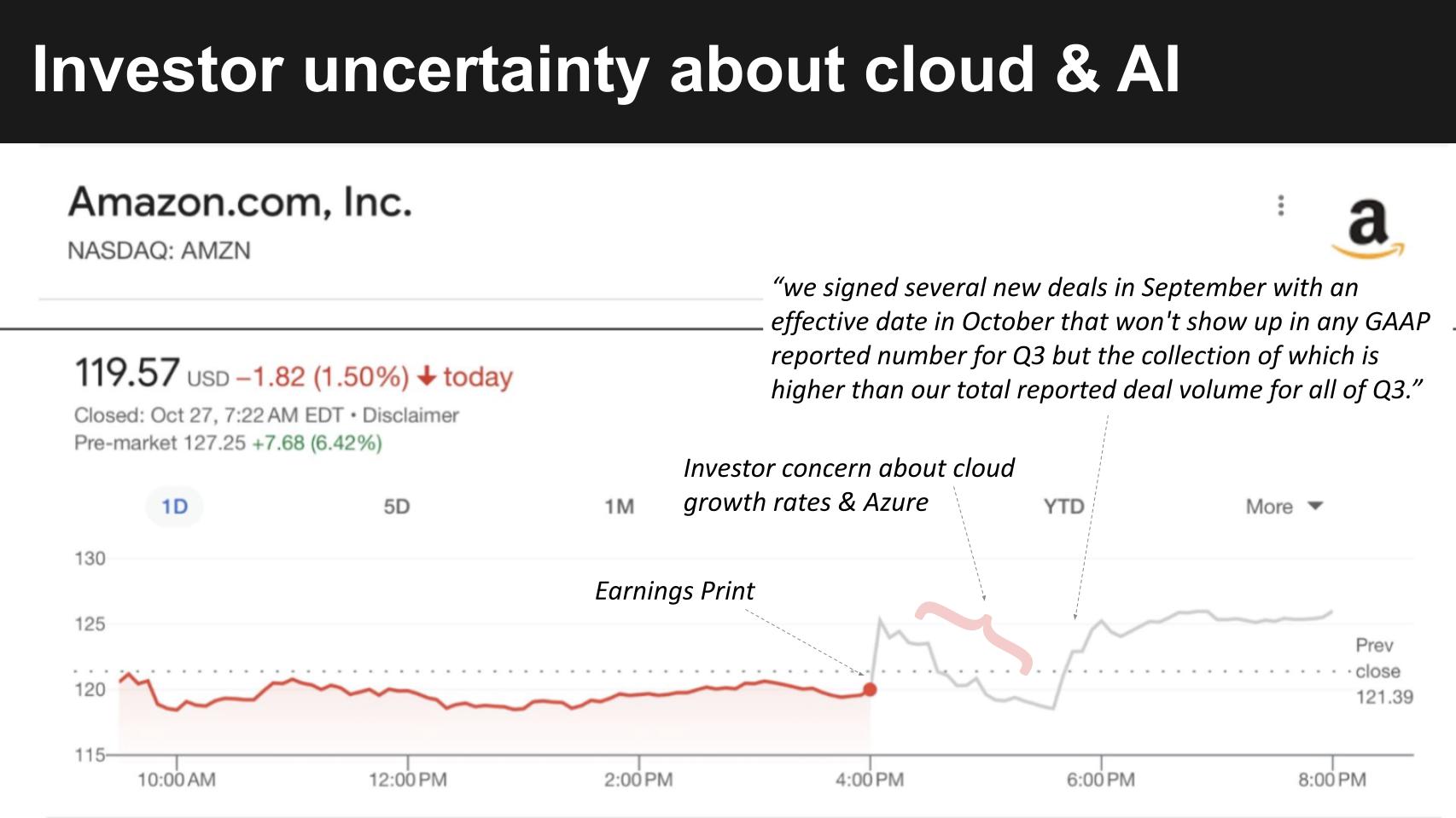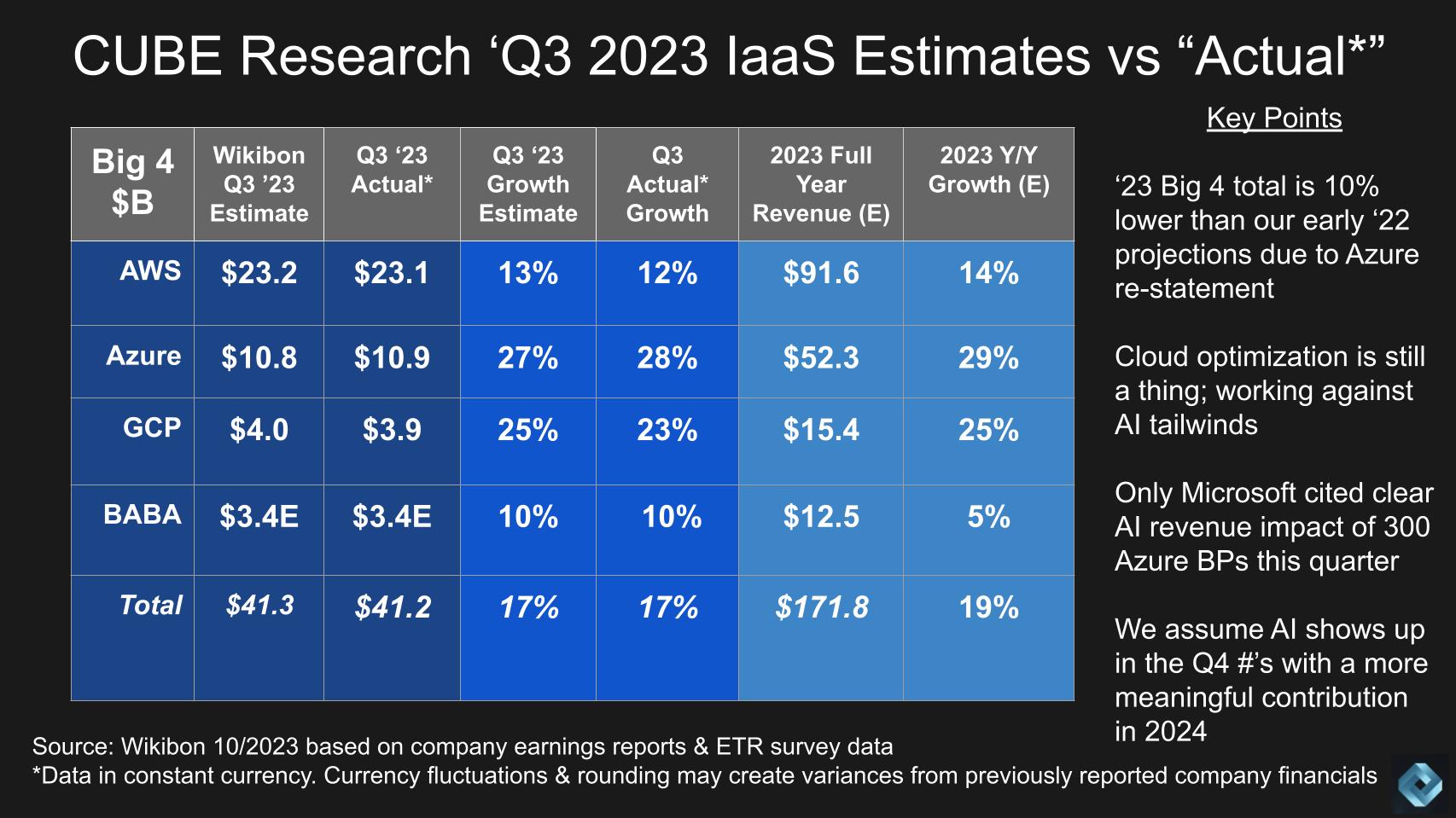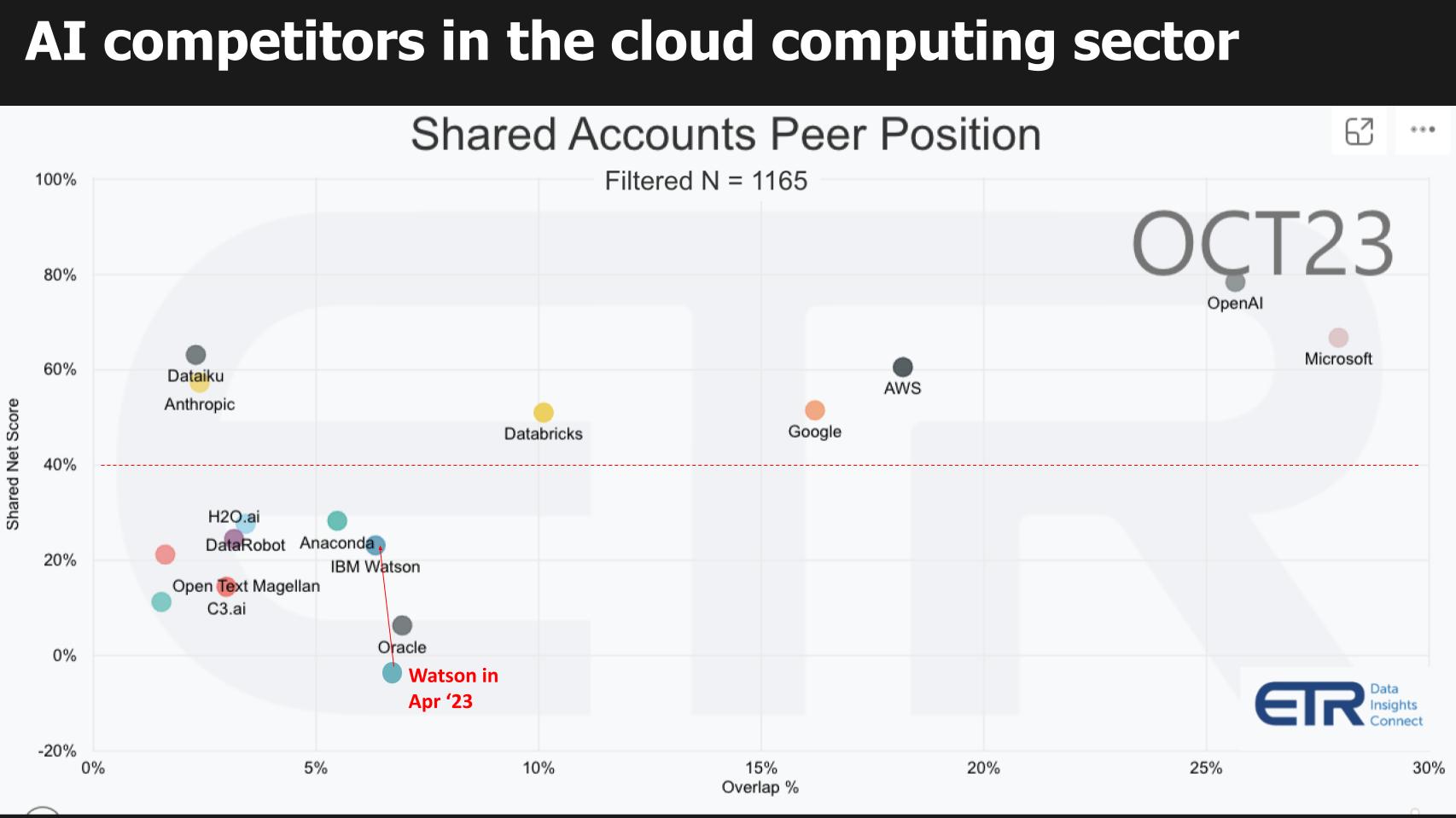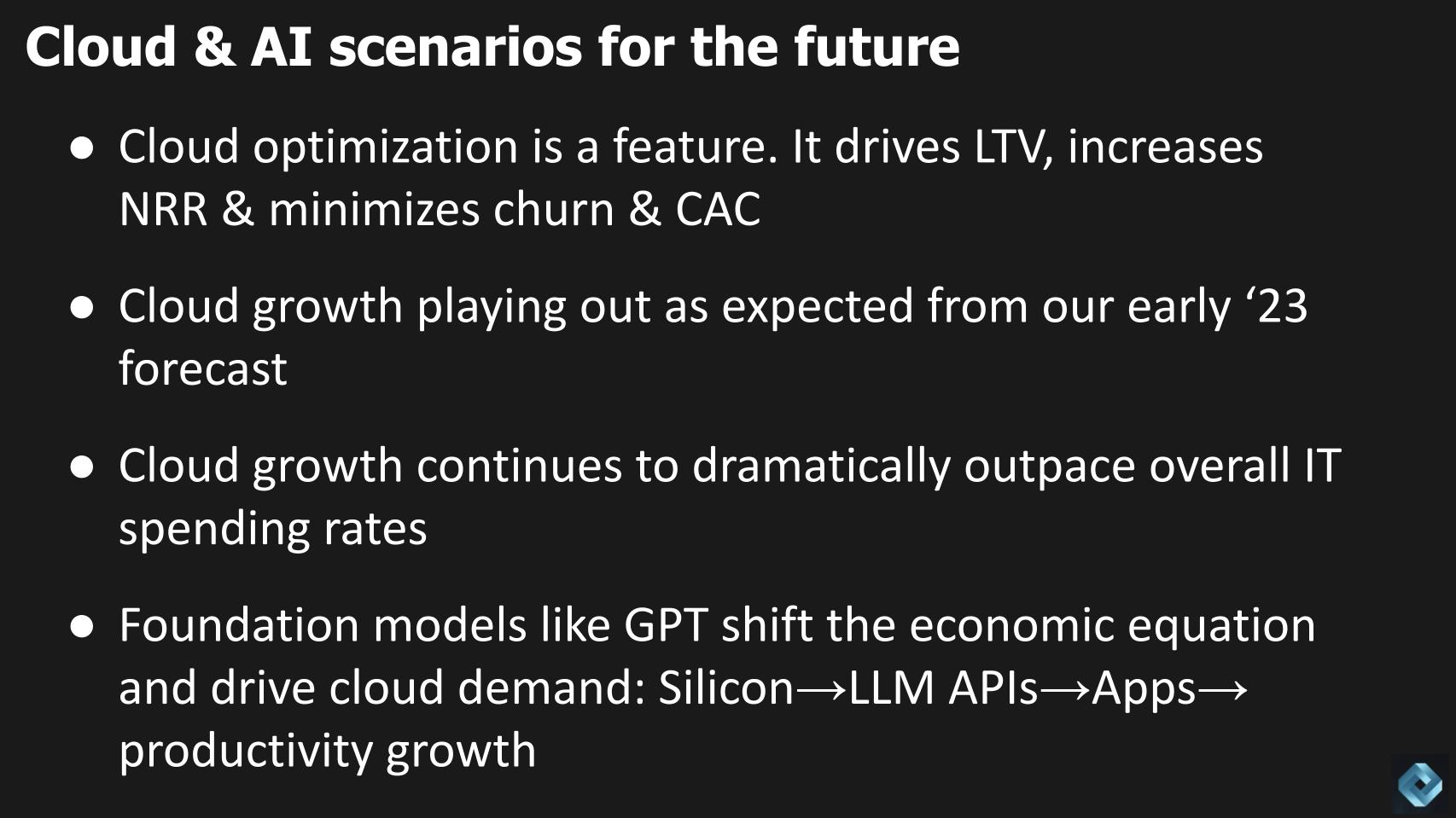 AI
AI
 AI
AI
 AI
AI
In 1987, Nobel Prize-winning economist Bob Solow famously observed, “You can see the computer age everywhere but in the productivity statistics.” This proclamation became known as the productivity paradox
Ironically, Solow’s statement preceded the greatest productivity boom since the dawn of the computer age, which subsequently came to fruition in the 1990s. It can be argued that a similar pattern is being seen today where artificial intelligence is everywhere but generally not showing up in earnings numbers or productivity statistics… yet.
In this Breaking Analysis, we squint through the latest earnings reports from Microsoft Corp., Google LLC parent Alphabet Inc. and Amazon.com Inc. to understand what’s happening in cloud, evaluate the impact or lack thereof of AI on cloud earnings momentum, and explain how we think about the future impact of generative AI and cloud.

The above chart underscores the mixed reactions from investors. It shows Amazon’s stock price the day it announced after the close (Thursday). The red line is during trading hours prior to its earnings release and after-hours is the gray line up through Friday morning before the open. The stock was down 1.5% during the day, then Amazon announced earnings.
After the print, the stock shot up after-hours because Amazon beat, but then the talking head “experts” on the financial channels started to question the attractiveness of of Amazon as an investment. One analyst on CNBC cited the tepid growth rate of its Amazon Web Services cloud unit compared with Azure as a negative. He said that he wouldn’t get excited again until AWS was growing in the high teens or even 20% range… and you can see above that narrative dampened enthusiasm after-hours.
As an observer of AWS and tech markets this reaction is perplexing. Here’s AWS, a $90 billion company growing at 12% with 30% operating margins. That’s north of Cisco Systems Inc. and, although south of Oracle Corp., it’s really fantastic. AWS basically came in on the number and its $7 billion of operating income only accounted for about one-quarter of Amazon’s overall operating profit. Remember we’ve seen that percentage exceed 100% in the past.
Not to mention, growth at Microsoft isn’t necessarily a negative for AWS prompting the following tweet while on a plane with CNBC in one ear and the earnings call on spotty WiFi in the other:
Microsoft is unique with a massive software advantage built up over decades. AWS is nearly the size of Dell with a profit model north of Cisco’s and a bit south or Oracle’s – it’s an incredible business.
— Dave Vellante (@dvellante) October 26, 2023
Now, Amazon’s guide for AWS was conservative, OK – why wouldn’t it be? There’s no upside in being too aggressive in this market. Then Amazon Chief Executive Andy Jassy says on the earnings call:
…we signed several new deals in September with an effective date in October that won’t show up in any GAAP reported number for Q3 but the collection of which is higher than our total reported deal volume for all of Q3.
The expert investor comes back on TV and basically says he may have to rethink his stance on Amazon. And you can see above how the stock reacted during the call, shooting back up, and as of midday Friday, the stock was up 7% while the Nasdaq was basically unchanged.
Takeaway: We’ve seen many waves over the years and what happens is when there’s a big disruptive trend that everyone knows is coming. It gets hyped up. But the reality is the size of the new is still so small that despite the momentum and growth, it’s just not nearly big enough to blow through any headwinds or other market friction — of which there is a lot today.
Given all the market uncertainty, CEOs are not allocating huge incremental dollars to chief information officers for AI. Rather, they’re saying, “Figure it out, show some ROI and we’ll invest more.”

As we’ve said in previous research notes, AI is stealing from other sectors. The chart above from Enterprise Technology Research’s latest spending intentions survey shows all the sectors the company tracks. The N in this study is more than 1,700 information technology decision makers or ITDMs. The Y axis is Net Score or spending velocity in a sector and the X axis is the pervasiveness of the sector in the data set. We show here via the squiggly lines that AI bounced off its low in October 2022, one month before ChatGPT was announced.
You can also see the trajectory of cloud computing over the last 10 quarters or so. Shifting budgets plus other factors including cloud optimization and a rebalancing of hybrid portfolios, has been taking place for over a year now. Notably, we see very few sectors over that red dotted line at a 40% Net Score – considered a highly elevated indicator of spend momentum.
Takeaway: AI is still experimental today. It’s showing lots of promise, but most activity remains at the evaluation stage. Resources are being allocated, but for the most part, they’re not incremental resources. Rather, they’re stealing from other buckets.
The cloud operating model continues to set the agenda for IT. Overall hyperscale cloud growth continues to outpace that of on-premises by a rate of four to five time. So let’s take a look at what the market for hyperscale clouds looks like post-earnings.

Above we show updated figures for our quarterly infrastructure-as-a-service and platform-as-a-service forecasts. Remember, this is meant to be apples-to-apples with AWS – i.e., we’re stripping out applications, collaboration software and things such as Microsoft 365 and Google Workspace. We consider the big four hyperscalers to be AWS, Microsoft Azure, Google Cloud and Alibaba. And we’ve been tracking these four for years.
The second column shows our previous third-quarter estimates compared with our new actuals based on the latest earnings reports. Alibaba has not reported yet. We then show the growth rates compared to our previous forecast and the latest full-year revenue estimates and corresponding growth rates.
The following key points are notable:
Let’s face it:. Microsoft is making all the right moves with AI and elsewhere across its portfolio including collaboration, database, security and more. Its performance is remarkable. So it’s somewhat understandable why analysts might be negative on AWS, but they’re missing the big picture, in our view.
Microsoft is a decades-old company with a giant software estate, which serves as a captive market for Azure. In other words, because Microsoft runs its own software on Azure, it has a unique flywheel effect that AWS doesn’t possess. AWS competes on the merits of its IaaS and PaaS and the fact that it has the best cloud services. But the point is there’s plenty of room for both, so don’t assume Azure’s success is necessarily a negative for AWS.
Having said that, the performance of Azure is astoundingly good. We have it growing nearly 30% this year to AWS’ 14%. The real concern we have is Google. It can be argued that Google has the best tech, the best AI and the resources to invest. But at $4 billion per quarter in IaaS, its growth rate should be at least double that rate, in our opinion. Both AWS and Azure at this same size were growing at rates of 60%-plus. Accounting for the fact that Google was late to enterprise cloud and is ramping up in times of much greater uncertainty, they still should be growing faster.
The last point on the chart above is that we fully expect accelerated growth in Q4 as a direct result of AI. We have the overall year-over-year growth rate of 17% this past September quarter, accelerating to 21% in the December quarter — with AWS, Azure and GCP growing at 17%, 30% and 25%, respectively.
While Azure and GCP are growing faster than AWS, AWS remains the largest IaaS/PaaS player in our models through the next 24 months at least. And we expect to see a re-acceleration of AWS growth.
For the first time in the cloud era, AWS is playing catch-up. The company is messaging, “It’s early days in generative AI.” But AWS has spotted the opponents a lead.

Above is a chart of 300 respondents from a recent ETR drilldown that asks which products from the cloud providers are currently in use (the blue bars) and are planned for evaluation (the yellow). Microsoft is winning right now, there’s little question. Google with VertexAI combined with BigQuery has a very strong data story – despite the fact that it’s not showing up in the numbers yet. And interest in Amazon is quite high. Note the parenthetical (“if generally available”). Amazon Bedrock went GA this month and, with re:Invent around the corner, one would have to believe that AWS will have the last word this year on Gen AI and it will be a strong one.
Several points stand out:
The graphic below shows Net Score or spending velocity on the vertical axis and presence in the sector on the X axis. This data filters on 1,165 cloud computing accounts in the ETR data set. It then cuts the data by ML/AI platforms that buyers are deploying. The red dotted line at 40% indicates a highly elevated spending velocity on a platform.

OpenAI’s lead and Microsoft’s bold strategy have put these two firms in a prominent position. They’re crushing it relative to the rest of the crowd. It’s notable how AWS and Google have come more closely aligned when you cut the data on cloud and AI. Normally AWS would be much closer to Microsoft than to Google but not when the data is filtered on AI. Now as a caution, remember Microsoft is so large and ubiquitous that it skews the data toits favor because of the massive software estate it has. But nonetheless, AWS clearly has some work to do despite the fact that it’s well above the 40% Net Score mark.
Our strong bet is that AWS will see accelerated momentum coming out of re:Invent, just as Google saw coming off Next and IBM off Think. AWS could be sitting pretty next year.
We also want to point out Anthropic, which is not as prominent on the X axis but clearly is showing market momentum. Everyone seems to be working with Anthropic, including Google’s recent announcement to invest and partner with the company. And you may recall in the previous chart that the “other” category of AI players being adopted or evaluated was meaningful. So as we’ve been saying with our Gen AI Power Law research, the tail in AI will be long.
IBM for years was marketing Watson hard with unimpressive results. But watsonx from a product standpoint is looking good. Watsonx supports open data formats and has strong metadata management. It supports many data types, multiple database and query engines and has a decent data-sharing story.
Look at IBM Watson in the above chart. While it’s still well below the magic 40% red line, look at where it was in ETR’s April survey of this year. IBM announced watsonx in May at its Think conference and is showing momentum. CEO Arvind Krishna’s hybrid cloud narrative has expanded to include generative AI and IBM has an unfair advantage with its consulting business.
What do we mean by this? When IBM bought Red Hat, we said this was really a consulting and services play. Or at least that was why the deal made economic sense, because IBM’s services business de-risked the acquisition. Why? Because IBM’s strong consulting business allows it to have a captive market for its software and other products. Provided that watsonx is competitive – and by our initial assessment it appears to be so – it should do well in market. After years of torturing us with Watson mumbo-jumbo bolstered by great advertising, IBM, we believe, got it right this time around.

Cloud optimization continues, but it is a feature, not a bug. It drives lifetime customer value, it increases net revenue retention rates and minimizes churn. This in turn keeps customer acquisition costs managed and can drive attractive LTV/CAC ratios above four times.
Cloud growth is playing out as expected from our early 2023 forecast. With the exception of the restatement of Azure, we’ve been pretty much dead on. Certainly at the total market level – perhaps a bit too optimistic with Google. But Microsoft has made up for that.
Cloud growth continues to dramatically outpace overall IT spending rates. The 19% growth on a $170 billion market is pretty impressive, while on-prem growth hovers in the mid-single digits. How generative AI will affect these growth rates remains to be seen, but in general we see a rising tide lifting most ships.
Foundation models such as GPT shift the economic equation and drive cloud demand: Silicon→LLM APIs→Apps, which drive compute, storage and other infrastructure. Importantly, it must also drive productivity and address rising labor costs or enterprises will become more cautious, in our view.
But on balance, we expect an acceleration in Q4 cloud growth, driven by gen AI, and into 2024 with the obvious macro caveats that we’ll be watching.
Thanks to Alex Myerson and Ken Shifman on production, podcasts and media workflows for Breaking Analysis. Special thanks to Kristen Martin and Cheryl Knight, who help us keep our community informed and get the word out, and to Rob Hof, our editor in chief at SiliconANGLE.
Remember we publish each week on Wikibon and SiliconANGLE. These episodes are all available as podcasts wherever you listen.
Email david.vellante@siliconangle.com, DM @dvellante on Twitter and comment on our LinkedIn posts.
Also, check out this ETR Tutorial we created, which explains the spending methodology in more detail. Note: ETR is a separate company from Wikibon and SiliconANGLE. If you would like to cite or republish any of the company’s data, or inquire about its services, please contact ETR at legal@etr.ai.
Here’s the full video analysis:
All statements made regarding companies or securities are strictly beliefs, points of view and opinions held by SiliconANGLE Media, Enterprise Technology Research, other guests on theCUBE and guest writers. Such statements are not recommendations by these individuals to buy, sell or hold any security. The content presented does not constitute investment advice and should not be used as the basis for any investment decision. You and only you are responsible for your investment decisions.
Disclosure: Many of the companies cited in Breaking Analysis are sponsors of theCUBE and/or clients of Wikibon. None of these firms or other companies have any editorial control over or advanced viewing of what’s published in Breaking Analysis.
THANK YOU